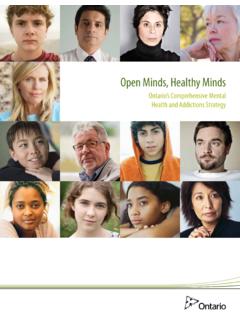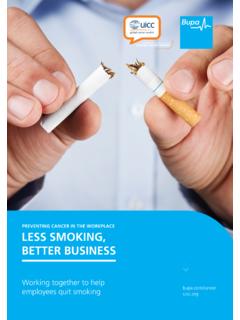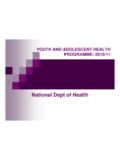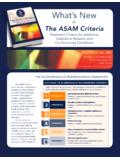Transcription of Work-related stress - Health and Safety Executive
1 Health and Safety Executive Health Sector priority plan forplan: Health and Safety : Work-related stress Work-related stress (WRS) is the second most When it is prolonged, WRS can lead to commonly reported cause of occupational ill Health mental Health conditions such as anxiety and in Great Britain. depression, as well as physical conditions. The key stressors most often identified are While the highest incidence rates are recorded in the high workloads, high demands and insufficient public services education, Health and social care, support from managers. prisons, emergency services, and local and central government there is increasing evidence that it is becoming a significant problem in other sectors.
2 Current position WRS accounts for 37% of all ill Health cases and The overall economic cost to Great Britain was 45% of all working days lost due to ill Health . The estimated to be over 5 billion. total number of working days lost in 2015/16 was million, with an average of days per case. HSE stress statistics: Of the 488 000 cases, 224 000 were new in that year. Outcomes and priorities We want to see: a significant increase in the number of cross-sector learning about what works';. employers taking a proactive (rather than recognition that preventive action on WRS. reactive) stance to managing WRS through can make a valuable contribution to the wider the Management Standards approach or other mental Health agenda.
3 Suitable risk assessment methodology;. more HR and Health and Safety professionals trained and competent to implement Management Standards approaches within their organisations;. Health and Safety Executive What HSE will do to #HelpGBworkwell We will lead and engage with others to improve workplace Health and Safety by: hosting an 18-monthly National Summit to raise the profile of WRS;. engaging influential industry stakeholders, HR professionals, trade unions and the wider Health and Safety community to drive forward behavioural change in raising awareness of the effect on individuals and business performance.
4 Using insight research to better understand how to reach and engage with prioritised sector audiences;. using communication and social media channels that resonate with industry to promote benefits to both the business and the workforce of effectively managing WRS risk factors through a proactive, preventive approach;. publishing refreshed online WRS guidance and tools by the end of 2017;. producing a recognised qualification for the HR profession and Health and Safety practitioners in implementing the Management Standards approach by the end of 2018;. providing benchmarking data available by sector and business size.
5 Producing cost-benefit case studies;. promoting engagement via HSE's stress ebulletin, ecommunity, and social media to extend our communications reach, particularly with SMEs;. encouraging improved knowledge sharing and transfer of good practice. We will secure effective management and control of risk by: conducting pilots in sectors with high reported levels of WRS (initially schools, healthcare and prisons) to promote the Management Standards approach and, where appropriate, consider the development of customised guidance to facilitate wider adoption across the sector;. evaluating and reporting on the pilot process at six-monthly intervals to encourage and enable other sectors to take similar ongoing action, independent of direct HSE support.
6 Working with others in government to provide integrated advice and guidance wherever possible;. developing a suite of leading indicators that will measure stress risk management performance in businesses/sectors by the end of 2018. We will provide an effective regulatory framework by: researching the continued effectiveness of the Management Standards approach;. gathering evidence from industry, academia and research bodies to inform future activity.

















